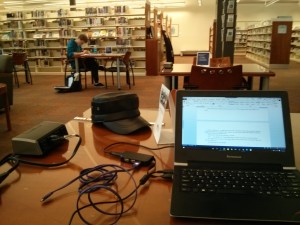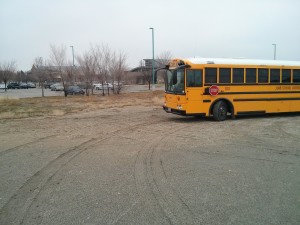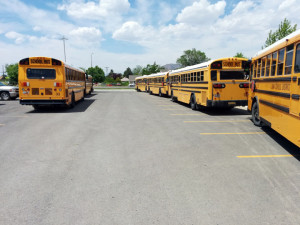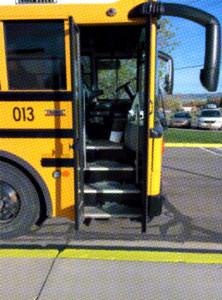Today was the last day of school for the 24-25 school year. What does that matter to a 63 year old man? Well, I’m a school bus driver. Believe me, it matters.
It’s funny how in just two hours a day a bus driver can create a relationship with every child on the bus. Of course it’s not the same relationship with each of them. The one thing that is the same is that I am their bus driver. That is where our relationship begins. How far our relationships go, I’m still discovering.
The realization that I am their bus driver was made clear to me on a recent activity trip. As the field trip kids came out of the school I stood beside the open cargo bay doors to assist in storing their sack lunches. One of the 3rd grade boys came running to me and threw his arms around my waist. He was one of my regular route kids, so we saw each other every day. He announced to anyone who was listening that “this is my bus driver.” What makes this remarkable is that this boy had never said a word to me in all the months I had been driving him, and now he was giving me a hug? I realized he was showing superiority over the other kids by claiming me: This is mine, not yours.
The ten months of taking the kids to school and then taking them home again are filled with good times and bad times. The collective mood of the kids changes from day to day. Some days the raucous noise that fills the bus is full of childhood joy and fun. Other days it’s full of complaints and belittlement. Individual kids will be acting out in ways that range from choking another kid (yes, it’s happened) to screaming as loud as they can (just for the fun of it). All of the in-between days are filled with kids constantly begging if they can sit with so-and-so even though they’ve been told “no” every time for months; kids standing up to whack the kid in front of them on the head; kids hopping seats; kids leaning out across the aisle. These things require your attention and somehow have to fit in with watching traffic and pedestrians. It all wears on bus driver’s a soul.
By the end of the school year—approximately ten months—any good nature I have is wearing thin. I often have thoughts that I’m not proud of.
Don’t they every miss a day?!
There are kids who don’t ride regularly. Then there are the kids who show up at 20 below zero, in blizzards, in fog, on half days, on the last day—kids who I would consider it a gift if they missed a day just once.
I say things I’m not proud of.
You’re riding today?
This is the kid who has choked others, peed on the bus, and more. When he’s on, anything could happen. Lately, he’s been doing much better, but still I cringe when I see him. I feel bad when I hear those words come out of my mouth.
I have feelings I’m not proud of.
I’m not going to miss a one of you all summer.
I truly love each of the kids, but at the moment the thought is sincere.
That’s why, on the last day of summer, I was humbled.
In spite of the celebratory nature of the day, it started off badly. The family-that-never-misses-a-day was there, of course, even though there would only be three hours of school. Not missing school is a good thing. I know that, but two children from this family are moody. On good days they are delightful. On moody days they are a bus driver’s nightmare. This final morning started off with the girl, Zinnie, yelling (screaming) at me for letting a certain boy sit with her brother but not letting a certain girl sit with her. Not up for the fight I had the boy move. My intention was to shame Zinnie. When the boy asked why he had to move I said, “Because Zinnie demands that you do. Zinnie won’t allow you to sit there. Zinnie must have her way. Instead of being shamed, Zinnie sat taller in her seat as if saying, “Yes, everyone should do just as I say.” The rest of the morning went smoothly enough.
At 11:30, when the kids left the school for the final time, there was joy in the air. There was even more joy in my heart. This daily wrestling match would be over for a couple of months. Kids nearly floated onto the bus, their excitement was so strong. Little Marsha got on the bus wearing a paper birthday crown and carrying a white paper plate. On the plate was a pretty cupcake with pink frosting.
“Happy birthday!” I said. “I didn’t know it was your birthday.”
She smiled happily and held the cupcake toward me.
“What? No. That’s your birthday cupcake. You eat it.”
She pushed it closer to me.
“You want me to have it? Okay.” I thanked her and hesitantly took it.
She beamed.
Apparently she had really wanted to give me, her bus driver, a gift.
Then, Zinnie ran up the steps.
“Tory, look!” She held up a KitKat candy bar. “They gave me this for graduating elementary school.”
“You go to six years of school here and they give you a KitKat?” I asked. “Was it worth it?” I was being my end-of-year cynical self and I hated it. I just couldn’t stop the words coming out of my mouth. Luckily, she took no notice.
“Uh huh,” she responded while cheerily ripping the wrapper open.
A few moments later she called to me. “Tory, this is for three years of driving me to school.”
She held the last stick of the KitKat toward me in its wrapper. There was melted chocolate coating the inside.
“What? No. That’s your graduation KitKat,” I protested.
“I want you to have it.” She looked me in the eyes and almost sounded angry. I could tell that she wanted to eat that last stick of KitKat. She loves KitKats.
I tentatively raised my arm. She slapped the candy into my hand, turned, and rushed back to her seat. Her body language told me that she really, really wanted that last piece of the KitKat and had to hurry away before she took it back and gobbled it. In my end-of-year orneriness, as I stood there with melted chocolate in my hand, I was touched at her sacrifice.
Thirty minutes later we were at the first stop in Levan. The kids filed off full of summer dreams. Becky, a diminutive but willful first grader, stopped at my seat, put an arm around my neck and squeezed. I was astounded. This little gal hadn’t said a word to me all year even with all my “Good morning, Beckys,” and “Have a good afternoon, Beckys.” She didn’t just not answer; she would purposefully not look at me. She gave me the feeling that said, “You are an authority figure and I don’t like authority figures. You think you can tell me what to do, and you can’t.” And here she was giving me an affectionate hug? Didn’t she know that although I loved her I didn’t really like her? Apparently not. She was telling me, “You are my bus driver and I’m going to miss you this summer.” At least I think that’s what she was telling me. In any case, I was grateful for that hug. Really grateful. It put things back into perspective.
A tough, little second grade boy following Becky also gave me a hug. His didn’t surprise me quite as much. He’s a little cowboy and I wasn’t sure that cowboys hugged. On the other hand, every afternoon when I dropped him, he would turn on the top step and say, “Thank you, Tory.” That is one thing I never got tired of.
As I made my way around the other stops there were, “I’ll come visit you,” (they know where I live), high-fives from my driver’s window, and “See you in the fall.” It was a happy day.
After I dropped my last student I drove the bus home for the last time of the school year. I already felt the relief percolating up through my soul. Yet, I was troubled. These kids, of whom I was so tired, had given me beautiful, little tokens of love—love that I hadn’t known (or maybe I had only forgotten) that they felt for me. In my end-of-year orneriness my sensitivity had been dulled. I had stopped seeing the beautiful human beings that these kids were struggling to become. Fortunately, they hadn’t stopped seeing the good in their bus driver.
















